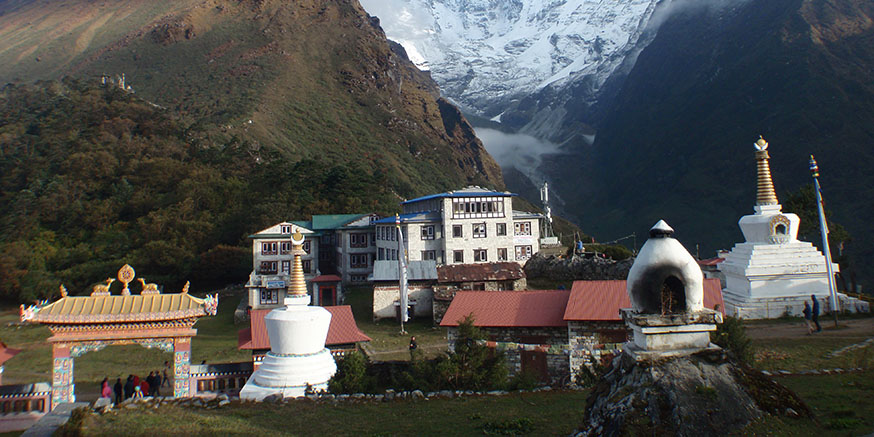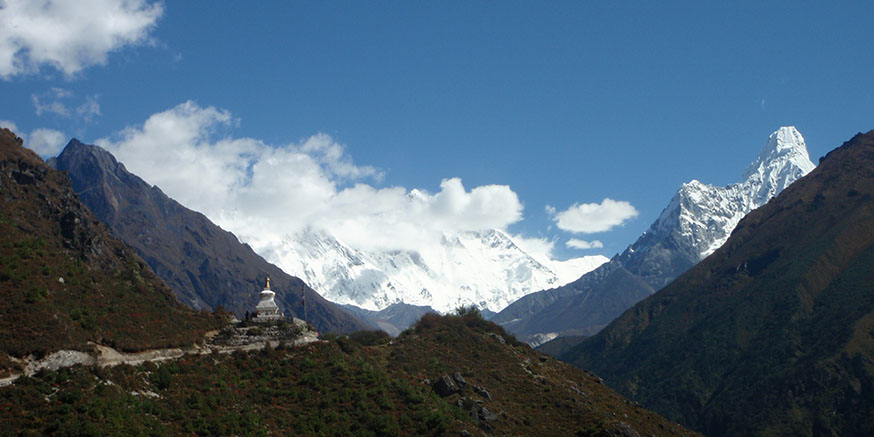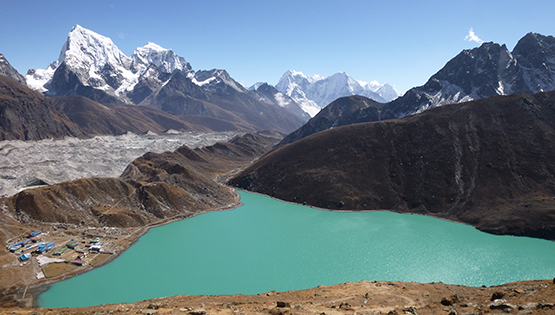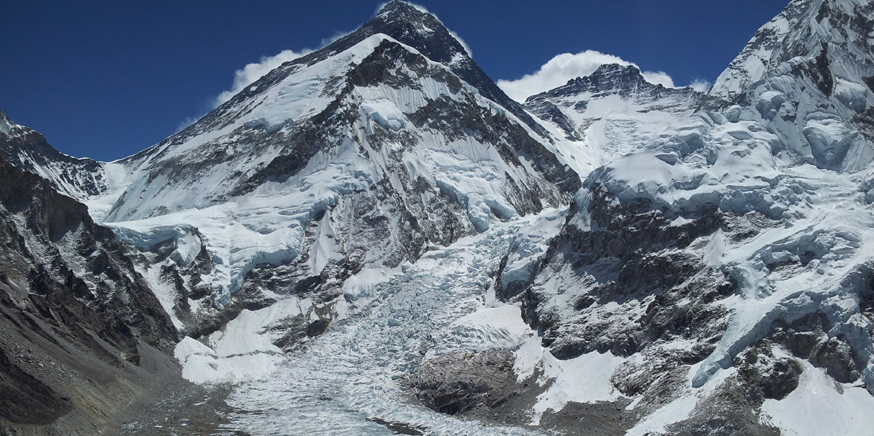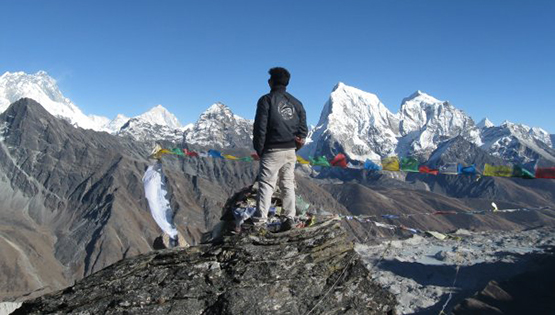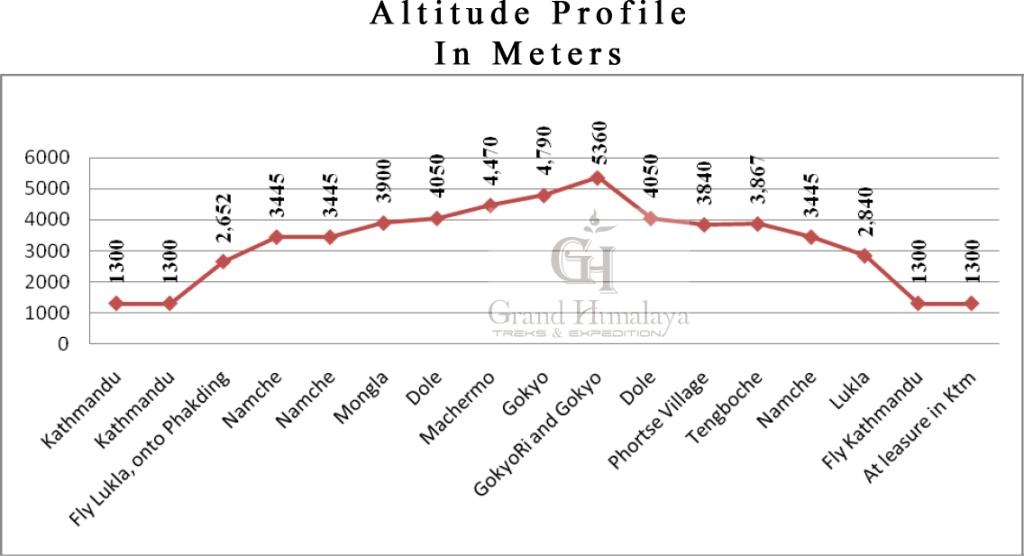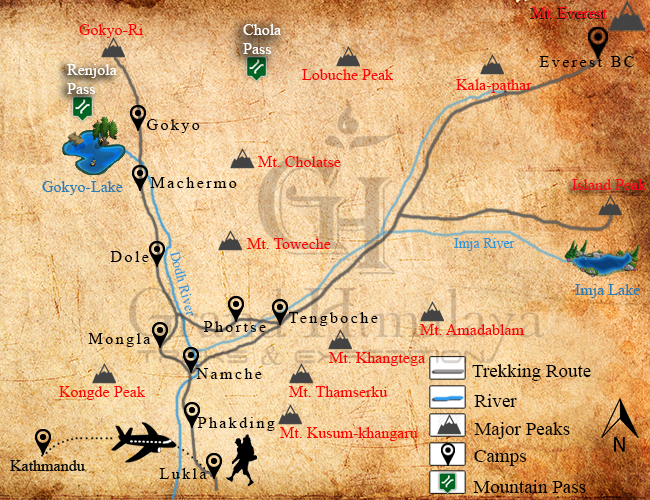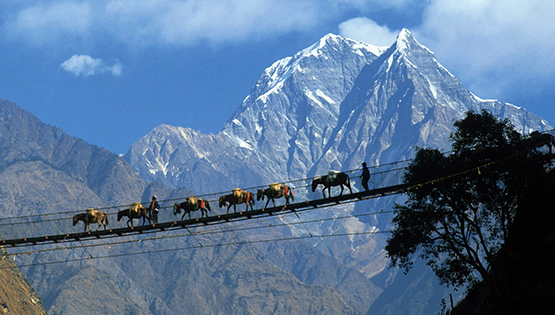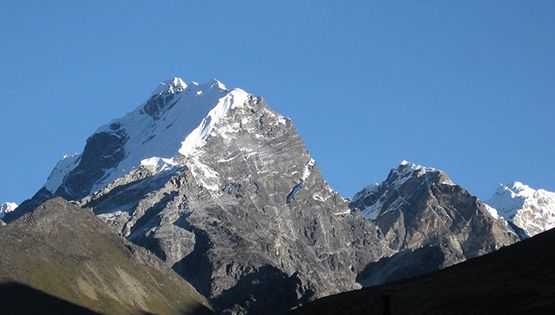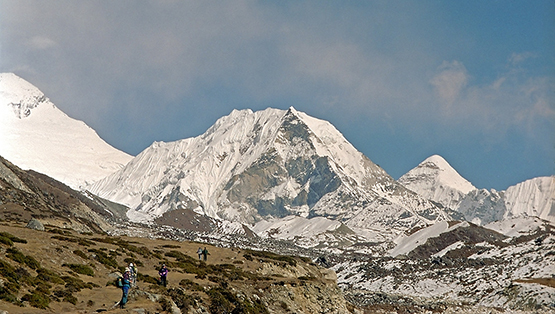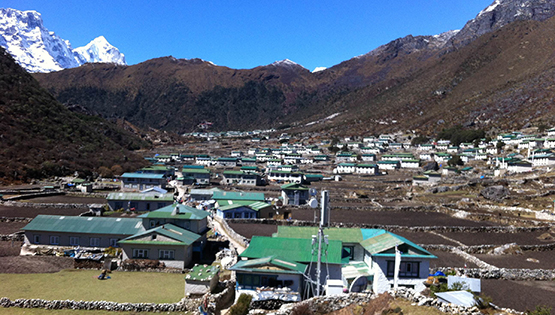The Gokyo Lakes region at the head of the Dudh Kosi Valley provides a great alternative to the popular Everest Base Camp trek. It is a more tranquil trek through the Sherpa heartland that affords ample time for acclimatization with opportunities to savor the mountain panoramas from beautiful alpine campsites. The highlights of the trek are our ascent of Gokyo Ri. From the summit we gain superb views of Everest as well as the 8000m peaks of Lhotse, Makalu and Cho-Oyu. And crossing chola pass glacier (5,380m) is a real fun adventure which gives you an opportunity to set your foot at the highest point of your life. Gokyo Tso (Lake), also called Dudh Pokhari, is the main lake with an area of 42.9 ha (106 acres), and the village of Gokyo lies on its eastern shore. Gokyo Lake in Nepal's Sagarmatha National Park, located at an altitude of 4,700m (15,400ft) above sea level. Unique among natural heritage sites world-wide is the Sagarmatha National Park, which includes Mt. Everest (8,848 m) and other high peaks such as Lhotse, Lhotse Shar, Cho-Oyu, Ama Dablam, Pumori, Kangtega, Gyachung Kang, Thamserku, Kwangde, and many more.Located North-east of Kathmandu, Sagarmatha National Park is 1,148 sq km in area and consists of the upper catchment areas of the Dudh Koshi, Bhote Koshi and the Imja Khola (rivers). Much of the park lies above 3,000m. Sagarmatha is rugged with deep gorges, glaciers and nonnegotiable ice and rock faces. Phortse is one among the highest human settlement in Nepal, stood at an elevation of 3840meters/12598ft above sea level and it's quite a big traditional Sherpa village in Khumbu or Everest Region.Locally known as the 'Khumbu', it is the home of the famous Sherpa people. The Sherpas from Phortse village make a living by farming barley and potatoes, and graze their yaks in high altitude pastures. Young Sherpas have also made their name in mountaineering and the trekking industry has of late become the community's economic mainstay. It's been nearly a decade now since the American foundation called Alex Lowe charitable foundation along with NOLS have started a climbing school in this village and it's the only as well as first mountaineering school in the whole Everest region.Famous for its spectacular mountain peaks and the loyalty and friendliness of its inhabitants (the Sherpas), the Everest region (Khumbu) is one of the most popular destinations for tourists in Nepal. In 1979 the park (Everest National Park) was declared a World Heritage Site.While trekking is possible in this area the whole year round, the best times to visit are from the beginning of March to mid May and from the beginning of September to mid November. The winters are very cold and snow may make it difficult to travel higher than Tengboche, and also lodges may be closed above this altitude. Summers, on the other hand, are wet, and the spectacular peaks are often lost in the clouds. April and early May is a good time to see the hedgerows and trees bursting into bloom, with Rhododendrons, in particular, adding a spectacular splash of color to the landscape. However, dust from the plains of India during the spring routinely provides less than ideal conditions for clear mountain views. The views are much better after the summer monsoons have cleared the atmosphere of dust, but the days are shorter and cooler.Wildlife most likely to be seen in Sagarmatha is the Himalaya Tahr, Ghoral, Musk deer, Pikka (mouse hare) weasel and occasionally jackal. Other rarely seen animals are Himalayan black bear, wolf, lynx and snow leopard. Birds commonly seen are Impeyan pheasant, blood pheasant, snow cock, snow pigeon, red billed and yellow billed chough, Himalayan griffin vulture and lammergeyers. Sagarmatha National Park is also known as Khumbu region and sometimes, Everest region.
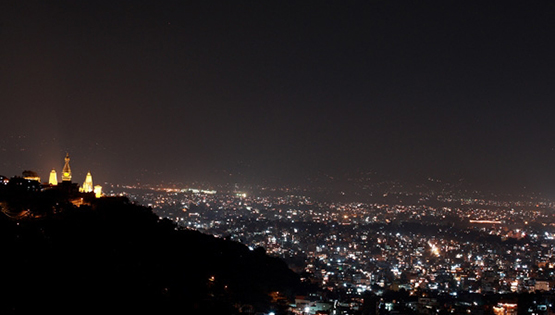
A very warm welcome to the Kingdom of Himalayas. Upon your arrival at the Tribhuvan international airport our representative welcomes you and assists you transfer in your hotel in Kathmandu. After time to get refreshed, evening you'll meet and transfer for welcome dinner in one of the typical Nepalese restaurant in the heart of Kathmandu i.e. Utsav or Nepali Chula (Kitchen). Here you will not simply experience the traditional Nepalese dish but will be entertained with Nepalese traditional dance and folk songs. After the dinner, you will be transferred back to your respective hotel.
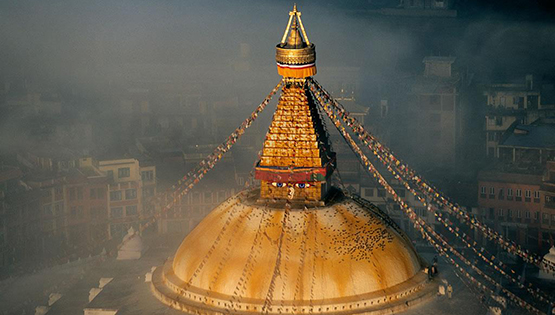
Kathmandu is the historical and cultural heart of Nepal and has been a popular destination for tourists ever since Nepal opened its doors to visitors. The city presents a wonderful mix of Hinduism, Tibetan Buddhism and Western influence in the Valley. Bauddhanath: Stupa with its 130 ft. dome. One of the world's largest Stupa, Bouddha is generally acknowledged to be the most important Tibetan Buddhist monument outside Tibet. Pupshupatinath Temple: Pashupatinath is considered one of the holiest shrines of all the Hindu temples. The temple has remained the presiding deity of ruling Nepalese Royalty. -After the city tour, our leader or guide will do the final briefing of the expedition. They will also take the opportunity to check the members' personal equipment as the city bazaars and climbing shops will provide the last chance to correct any deficiencies. Overnight at Hotel.

It's a panoramic thrill flying into Lukla in a Twin Otter plane on a clear day. The views of snow-capped mountain peaks sprawling around you outside your plane are almost ecstatic, beginning a whole chain of memorable experiences that stay with you for a long, long time. This is an exciting flight, which should give a glimpse of Everest in the distance. Don't forget to grab the left hand sit of the plane to catch the astounding glimpse of the Himalayas. In Lukla, we will meet our trek staffs and porters and set off straightaway for our first night's stop at Phakding 2,652m. Situated on the banks of the Dudh Kosi, which drains the whole of the Khumbu Region, this small hamlet is on the main trade route through the area and there are a number of clean, well-built lodges where we can spend the night.

We will continue up the banks of the Dudh Kosi, crossing it twice by small suspension bridges before reaching the Khumbu National Park. We will then cross the confluence of the Dudh Kosi (River) and the Bhote Kosi on a high suspension bridge and climb steeply for about two hours up 'Namche Hill' to reach Namche Bazaar (3,445m/11302ft). This is a prosperous trading town and the capital of the Khumbu Region. Many Tibetans cross the nearby border to trade their wares and the local market is a fascinating spectacle. This is a good place to buy genuine Tibetan artifacts. Just across the valley to the east stand the peaks of Thamserku and Khangtega, both very impressive mountains with the altitudes of 6000 to 6600 meters.
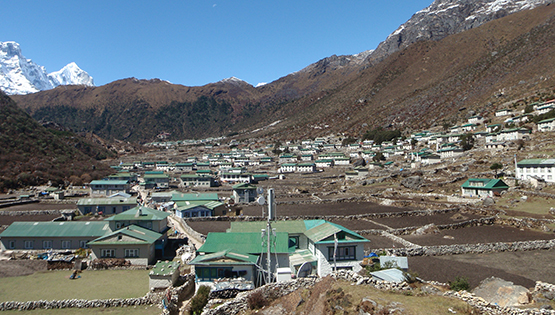
Namche Bazzar is the highlight of EBC trek and the heart of the Everest (Khumbu) region which has government offices, ATMs, Internet cafes, shops, restaurants, a bakery and a colorful market each Friday evening and Saturday. This is first scheduled 'acclimatization' day for this trek. Health experts always recommend us to stay active and moving during the rest day too instead of being idle. If we trek few hundred meters vertical during the day, it will help us to acclimatize with the alien heights that we are going to confront on the trek. Having been born, leading and organizing trips in the Himalayas, we believe in the natural process of acclimatization... "Climb high, sleep low". We take an interesting side trip up to Khumjung and climb up to famous airstrip at Syangboche. Just above the airstrip is the Everest View Hotel (3800m), a Japanese scheme to build a deluxe hotel with great views of the highest mountains on Earth. The Khumjung valley surrounded by the snowy peaks of Kongde and Thamserku, and the sacred peak the Khumbiyul-lha hosts a well known monastery that houses a yeti scalp. Visit Hillary School which is at the same site and spending some time in Khumjung after having lunch there, we walk back down to Namche Bazaar. Overnight at Namche Bazaar.
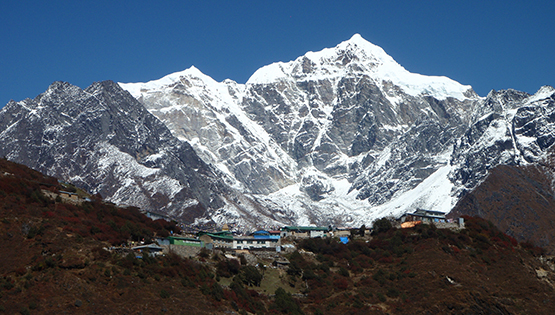
After 1 and 1/2 hour of walk on a nice and wide flattish track, we'll get to a place called Kyangzoma, an intersection point of a traditional route to Everest Base Camp and route to Gokyo. The special credit goes to Mr. Pasang Sherpa who spends all his days garnering donations from passersby, with the help of which he amends the well-worn track. After kyangzoma, we’ll take left turn and then follow steep up for around couple hours, until we arrive at Mongla. Note that descending to Phortse Tenga would mean sleeping only 100 meter above Namche, although a lot of trekkers do so. Spending a night here in Mongla rather than Phortse Tenga will surely be a plus point to your acclimatization.
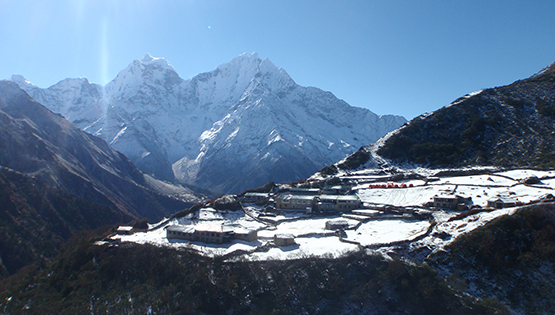
After the breakfast, it’s a steep descent of 300 meters until we get to upper Phortse Tenga where you will see a single lodge nestled in the woods. Please keep your attention alert because this place is mostly inhabited by Impeyan Pheasant (Danphe) and Blood Pheasent. The trail climbs steeply out of valley through rhododendron forest, which gives away to fragrant stands of juniper and large conifers. This part of the trek is especially beautiful in spring when the rhododendrons are in full bloom. The trail passes through Yak Kharkas (Cattle pen) and summer settlements, and then climbs gently to Dole. The views of Khumbiyul-lha and Tawoche are magnificent throughout the day, and it is possible to climb a ridge behind Dole for an even broader view up and down the valley in the afternoon.
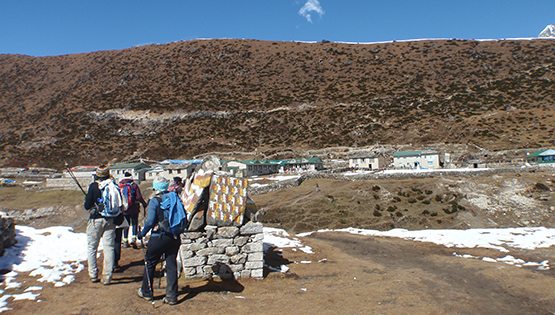
Today is another short day starting with a climb out of the small Dole Valley before ascending more gradually up the Dudh Kosi Valley, high above the River. The walk is easy though we'll feel the effects of altitude on even the smallest hill. The barren alpine scenery with only small clusters of dwarf juniper and rhododendron are the stark contrast to the white snowy peaks and deep blue skies. After 2 hours we'll arrive at Luza (4360m) and after a further hour's walk, we reach our lodge at Machermo (4470m) where we spend the evening. After lunch there is an option of taking an excursion across rocky moraines to the base of Kyajo Ri (6168m) and Machermo Peak (6073m). However, keep an eye open for the yeti! It was here in 1974 that three yaks were killed and a Sherpa girl injured when trying to fight off a hairy, ape-like intruder!
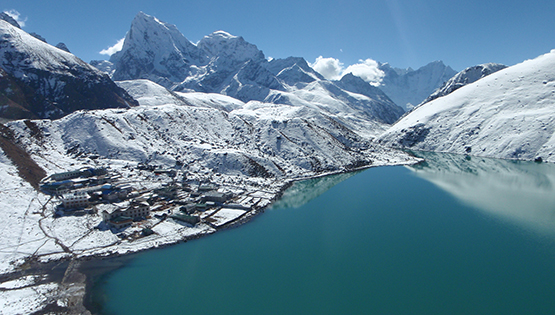
A short, steep climb leads from the Machermo Valley on to the steep grassy slopes of the Dudh Kosi Valley. Keep an eye open for the colorful Tibetan snow cocks, often found in this area. The valley widens as we pass through Phangka (4390m) and on to the jumbled, terminal moraines of Ngozumpa Glacier, the largest in Nepal and the source of the Dudh Kosi River. Climbing steeply over a rocky trail we keep to the western side of the glacier to reach a small lake at the head of a wide valley and then pass a larger lake Longponga Tsho (4690m), before following the lateral moraines to the third lake at Gokyo (4750m). Gokyo consists of a number of stone dwellings surrounded by stone-walled yak pastures. Our lodge is located close to the lake and, if there are no clouds around, the sunroom can be distinctly warm in the afternoon. For those feeling energetic, it is worth ascending to the ridge at the back of Gokyo for views down to the mighty Ngozumpa Glacier.
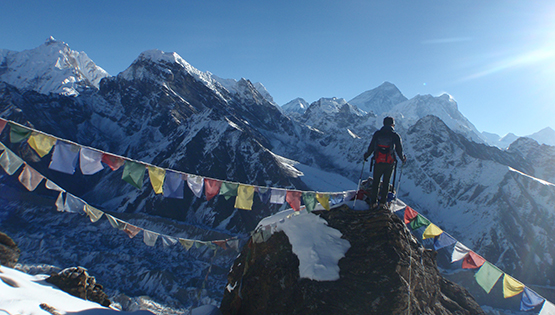
The earlier the better for an ascent of Gokyo-Ri to catch the glimpse of the fresh morning sun, crowning some of the gigantic peaks of the Himalaya. It takes between two to three hours to zig-zag our way up to the summit of this famous vintage point. The summit boulders are draped with prayer flags and the views towards Mt. Cho-Oyu (8201m) are particularly fine. We descend back down to Gokyo for breakfast, or, if we have made a early ascent, we will continue towards the fourth lake (Thonak Tsho). Gokyo is not only admired for its grand view but also for the six lakes which it hosts. Definitely we would not miss the chance to observe the fourth lake (Thonak Tsho) and fifth lake (Ngozuma Tsho). About 3 km north of Gokyo is the fourth lake with its high cliffs and peaks rising above it. The trail continues to fifth lake. If interested, we climb on a hill at the edge of the Lakes to get astounding views of Mt. Cho-Oyu, Mt. Gyachung Khang, Mt. Everest, Mt. Lhotse, Mt. Nuptse, and Mt. Makulu. We can see a lot more from here - the spot is called Scoundrel's Viewpoint. Beyond the fifth Lakes is the Cho-Oyu Base Camp. Northern part of the fifth lake provides fabulous views of Cho-Oyu Base Camp and biggest glacier of the world- the Ngazumpa glacier. Overnight at Gokyo.
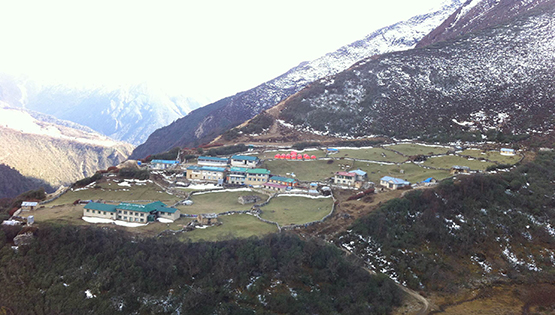
The way back from Gokyo is an easy downhill walk along the Dudh Koshi River that emerges out of the Ngozumpa Glacier. Passing by the second and then the first Gokyo Lakes, we come to a small gushing stream over an iron bridge. We see the hamlet of Phangka ahead. Cholatse and Taboche peaks rear up on the left of us. The trail descends below Phangka and across a level terrace on the slope to climb a rib, on the far side of the hill side. Upon reaching the Chorten at the edge, we see great views of Thamserku, Cho-Oyu, and Khangtega. We slowly walk down to sprawling village of Machermo. Again, through the charming hamlet of Luza and Lhafarma we reach Dole. Overnight at Dole.

Taking last inspection back to Cho-Oyu range, we start steep descent to Phortse Tenga. Descending to Phortse Tenga (3250 m), we cross a bridge over Dudhkosi River and again trek up through the rhododendron forest, a host for Himalayan wild deer, musk deer, Impeyan pheasant, and Blood pheasant. Finally, we arrive at the walled fields of Phortse. Phortse is nestled under the snow dusted peaks of Tawoche and Cholatse. It's a nice little village, only a few lodges and a fair number of traditional houses/farms. It's probably a bit like Namche used to be before tourism took it over. It's on a quieter trail so a bit nicer than the trail through Tengboche.
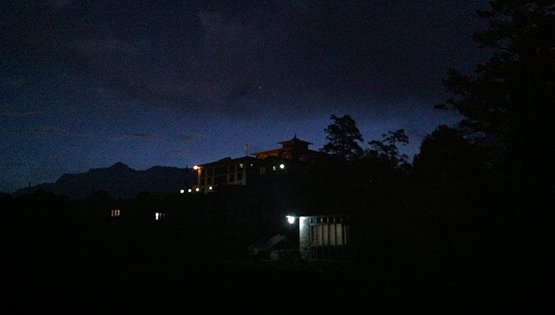
Today we continue along the high trail to Pangpoche and further towards Tengboche for the night. En route there is a funeral rock where dead bodies are cremated. The path contours along the side of the valley from here. After about an hour, Pangboche is visible in the distance below. The path zigzags upwards a little at this point. Eventually the path reaches its highest point and then it's all downhill to Pangboche. We'll have our lunch at Pangboche and now following the main Everest trail it's downhill to the river then a bit up to Tengboche. Tengboche is a home of an impressive and recently rebuilt monastery. We have plenty of time to look around Tengboche, visit the monastery and have a cake and coffee at the bakery.
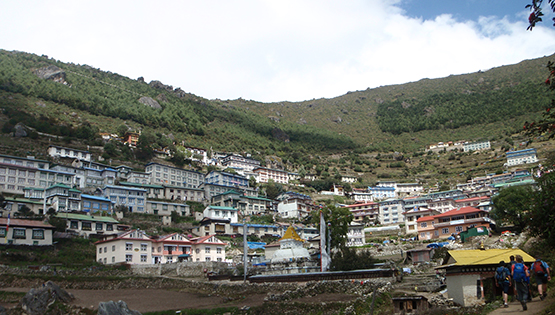
From Tengboche, a steep descent of around 1500ft/500m leads through bird filled Rhododendron bushes and fir trees to the Dudh Kosi River. Crossing on a newly built suspension bridge at Phunki Tenga, we climb up the opposite side of the valley to reach the contouring path leading back to Namche Bazaar. We should have enough time in Namche to shop and relax in the bakery with a coffee and a cake, or even to check the Internet. Good news is that there are Wifi in most of the lodges of Namche bazaar.
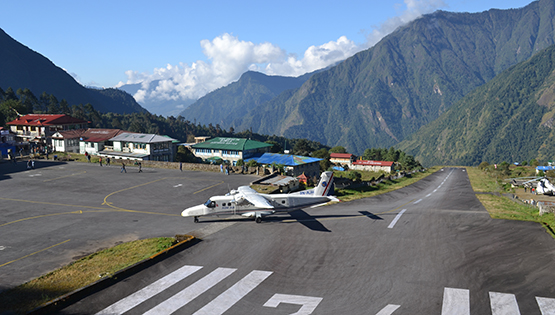
A steep descent for 600m/2,000ft down Namche Hill leads to the suspension bridge crossing the Dudh Kosi River and the small village of Monjo. Although we are travelling the same route down, we feel completely different views. We snap a mixture of open plains, rhododendron and pine forests, and in the distance snow covered peaks. We walk through the Sherpa villages' noticing impressive faith in Buddhism and culture of prayer stones and prayers flag. On arrival in Lukla, we stretch those sore legs and recall the experiences of the last one week. We experience the culmination of a fantastic trek on a happy note with everyone back safe and sound with smile! Overnight at Lukla.
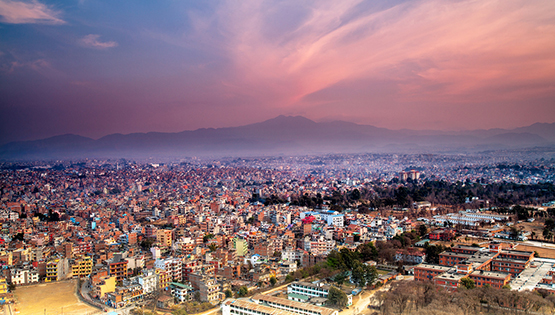
Saying final goodbye to our porters, we fly back to Kathmandu after our wonderful mountain journey. The flight time to Kathmandu are scheduled in the morning normally because Lukla suffers a lot of wind afternoon. Sometime the flight time can be delayed due to bad weather and other reasons. The early morning flight drops us at Kathmandu and the Grand Himalaya van or coach will transfer you to the hotel. You may have time to relax after long journey and take back your breath and rest at your hotel with ending your Himalayan expedition. Remember, we will be hosting a fantastic celebration dinner together in the finest restaurant in Thamel, in occasion of successfully completing your trip in the Himalayas!
Rest and relax at the hotel after such a wonderful trip. The day is also reserved as a contingency day due to flight delays or other unforeseen conditions. For those eager to see as much of Kathmandu as possible, an early start is worthwhile to visit the temples of Pashupatinath and Swayambhunath and districts of Bhaktapur and Patan. Durbar Square is also on the essential list, as is the shopping area of Thamel. In the evening you can have your last night in Nepal, enjoying the Nepali cultural dinner show or go out to Thamel.
Today is free or last minute shopping for souvenirs or gift to your family, friends or relatives for you until your departure flight/drive or to commence any extra trips or activities you may have booked with us. If departing, you'll be transferred to the International Airport for your departure flight to your onwards destination.
- 4 night hotel accommodation in Kathmandu in a 3 star category hotel. Breakfast is included. Accommodation is on a twin share basis. Single rooms are usually available at an additional cost. Please inform us as early as possible if you wish to have a single room.
- One day sightseeing tour in & around Kathmandu (largest Buddhist stupa in the world at Bouddha Nath and most important Hindu temple in the valley at Pasupati Nath and famous Monkey temple Swyambhunath). Either before or after the trek with tour guide and transportation. Other places will be on request list for additional cost if you wish.
- Sagarmatha National park entry fees,Khumbu Pasang Lhamu Rural Municipality Entrance Fee & all government taxes.
- Return Domestic flight ticket KTM-LUKLA-KTM (In Twin Otter) Clients and 1 Guide (No Helicopters Flight cost included). Please be advised, USD:500-800/-Per person extra cost will be applicable for chartering a Helicopter flight in case of bad weather disturbance on fixed wing Twin Otter flights IN/OUT of Lukla.
- All pickup and drop transportation from airport to airport both domestic & international airports. All guests are kindly requested to try and arrive in Kathmandu International airport at same time as much as possible for us to avoid multiple journeys to airport.
- Domestic airport taxes.
- One locally made water Proof Duffel bag with your Name & Grand Himalaya's Logo on it will be provided by us for the Trek, it is yours so you may take it back to home with you or return to us as you wish.
- All lodging & meals during the trekking period. 3 times a day & meal can be selected from the menu at local lodges according to individual choice, Breakfast/Lunch/Dinner/all hot drinks/plus two litres of boiled water per person/day on trek.
- An experienced local Sherpa guide
- Assistant Sherpa (4 trekkers = 1 assistant guide).
- Appropriate number of porters, 1 porter between two guests.
- Farewell dinner in Kathmandu after the trek, local cultural music and Dance show in well reputed restaurants, Bhojan Griha/Nepali Chula/Utsav with guide/staff (TBC)
- All local staff & porters properly insured & equipped.
- 1 Bottle of SUMMIT Oxygen with set of mask and regulator will be provided during the trek, (Just for emergency medical use only).
- A comprehensive medical kit. All guests are requested to bring their own personal First Aid Kit with sufficient medication supplies for trip.
- One regular/simple cell phone with local SIM Card & charger cable will be provided in the team during the trip. Guest will be requested to return this to Grand Himalaya staff at the end of the trip.
- Travel and rescue arrangements.
- International & home country domestic airfares, transfers en route & excess baggage.
- Your personal insurance: Medical, mountain rescue cover and repatriation is obligatory.
- Your personal expenses e. g phone calls, laundry, alcoholic beverage, mineral/bottled water, charges of showers, cost of electronic devices charging facilities and wireless internet (Wi-Fi) fees in the tea house.
- Main meals (Lunch & Dinner) in Kathmandu apart from celebration meal (Allow up to USD12-15 per meal).
- Your Nepal entry visa fee (USD $40 available on entry) Valid for 30 days.
- Tipping in Nepal & Tibet is customary. (Allow USD: 150-200/Per GUEST)
- Excess baggage above 15 kg will be extra charged USD: 1.5 per kg during the peak season.
- Extra night accommodation in Kathmandu because of early arrival, late departure, early return from mountain (due to any reason) than the scheduled itinerary
- Personal Trekking Gear.
| # | Start Date | End Date | Trip Cost | Availability | Booking |
|---|---|---|---|---|---|
| 1 | 3 OCT 2025 | 20 OCT 2025 | $2150 PER PERSON | Available | Book Now |
| 2 | 10 APR 2025 | 27 APR 2025 | $2550 PER PERSON | Available | Book Now |
| 3 | 27 MAR 2025 | 13 APR 2025 | $2550 PER PERSON | Available | Book Now |
| 4 | 11 NOV 2025 | 28 NOV 2025 | $2150 PER PERSON | Available | Book Now |
| 5 | 29 OCT 2025 | 15 NOV 2025 | $2150 PER PERSON | Available | Book Now |
| 6 | 16 OCT 2025 | 2 NOV 2025 | $2150 PER PERSON | Available | Book Now |
- More than 42 days before departure 30% of total cost
- 42 to 29 days 50% of total cost
- 28 days to 15 days 75% of total cost and
- 14 days or less 100% of total cost.
